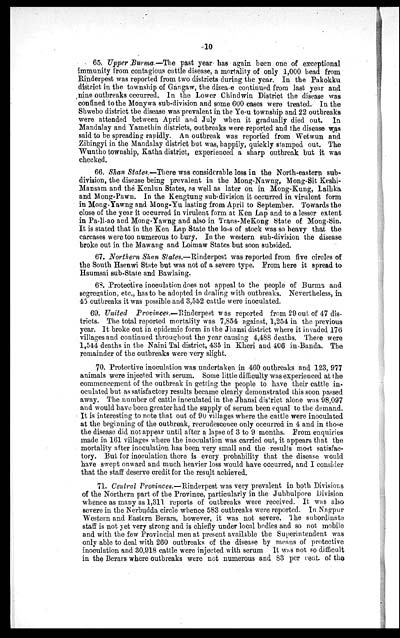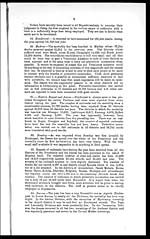Medicine - Veterinary > Civil Veterinary Departments > Annual administration report of the Civil Veterinary Department of India > 1907-1908 > Part A - Provincial administration
(21) Page 10
Download files
Individual page:
Thumbnail gallery: Grid view | List view

10
65. Upper Burma.—The past year has again been one of exceptional
immunity from contagious cattle disease, a mortality of only 1,000 head from
Rinderpest was reported from two districts during the year. In the Pakokku
district in the township of Gangaw, the disease continued from last year and
nine outbreaks occurred. In the Lower Chindwin District the disease was
confined to the Monywa sub-division and some 600 cases were treated. In the
Shwebo district the disease was prevalent in the Ye-u township and 22 outbreaks
were attended between April and July when it gradually died out. In
Mandalay and Yamethin districts, outbreaks were reported and the disease was
said to be spreading rapidly. An outbreak was reported from Wetwun and
Zibingyi in the Mandalay district but was, happily, quickly stamped out. The
Wuntho township, Katha district, experienced a sharp outbreak but it was
checked.
66. Shan States.—There was considerable loss in the North-eastern sub-
division, the disease being prevalent in the Mong-Nawng, Mong-Sit Keshi-
Mansam and the Kenlun States, as well as later on in Mong-Kung, Laihka
and Mong-Pawn. In the Kengtung sub-division it occurred in virulent form
in Mong-Yawng and Mong-Yu lasting from April to September. Towards the
close of the year it occurred in virulent form at Ken Lap and to a lesser extent
in Pa-li-ao and Mong Yawng and also in Trans-MeKong State of Mong-Sin.
It is stated that in the Ken Lap State the loss of stock was so heavy that the
carcases were too numerous to bury. In the western sub-division the disease
broke out in the Mawang and Loimaw States but soon subsided.
67. Northern Shan States.—Rinderpest was reported from five circles of
the South Hsenwi State but was not of a severe type. From here it spread to
Hsumsai sub-State and Bawlaing.
68. Protective inoculation does not appeal to the people of Burma and
segregation, etc., has to be adopted in dealing with outbreaks. Nevertheless, in
45 outbreaks it was possible and 3,552 cattle were inoculated.
69. United Provinces.—Rinderpest was reported from 29 out of 47 dis-
tricts. The total reported mortality was 7,854 against, 1,254 in the previous
year. It broke out in epidemic form in the Jhansi district where it invaded 176
villages and continued throughout the year causing 4,488 deaths. There were
1,544 deaths in the Naini Tal district, 435 in Kheri and 406 in Banda. The
remainder of the outbreaks were very slight.
70. Protective inoculation was undertaken in 460 outbreaks and 123, 977
animals were injected with serum. Some little difficulty was experienced at the
commencement of the outbreak in getting the people to have their cattle in-
oculated but as satisfactory results became clearly demonstrated this soon passed
away. The number of cattle inoculated in the Jhansi district alone was 98,097
and would have been greater had the supply of serum been equal to the demand.
It is interesting to note that out of 90 villages where the cattle were inoculated
at the beginning of the outbreak, recrudescence only occurred in 4 and in those
the disease did not appear until after a lapse of 3 to 9 months. From enquiries
made in 161 villages where the inoculation was carried out, it appears that the
mortality after inoculation has been very small and the results most satisfac-
tory. But for inoculation there is every probability that the disease would
have swept onward and much heavier loss would have occurred, and I consider
that the staff deserve credit for the result achieved.
71. Central Provinces.—Rinderpest was very prevalent in both Divisions
of the Northern part of the Province, particularly in the Jubbulpore Division
whence as many as 1,311 reports of outbreaks were received. It was also
severe in the Nerbudda circle whence 583 outbreaks were reported. In Nagpur
Western and Eastern Berars, however, it was not severe. The subordinate
staff is not yet very strong and is chiefly under local bodies and so not mobile
and with the few Provincial men at present available the Superintendent was
only able to deal with 260 outbreaks of the disease by means of protective
inoculation and 30,918 cattle were injected with serum It was not so difficult
in the Berars where outbreaks were not numerous and 83 per cent. of the
Set display mode to: Large image | Zoom image | Transcription
Images and transcriptions on this page, including medium image downloads, may be used under the Creative Commons Attribution 4.0 International Licence unless otherwise stated. ![]()
| Permanent URL | https://digital.nls.uk/75509489 |
|---|




